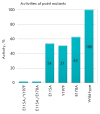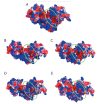Dual Active Site in the Endolytic Transglycosylase gp144 of Bacteriophage phiKZ
- PMID: 28461978
- PMCID: PMC5406664
Dual Active Site in the Endolytic Transglycosylase gp144 of Bacteriophage phiKZ
Abstract
Lytic transglycosylases are abundant peptidoglycan lysing enzymes that degrade the heteropolymers of bacterial cell walls in metabolic processes or in the course of a bacteriophage infection. The conventional catalytic mechanism of transglycosylases involves only the Glu or Asp residue. Endolysin gp144 of Pseudomonas aeruginosa bacteriophage phiKZ belongs to the family of Gram-negative transglycosylases with a modular composition and C-terminal location of the catalytic domain. Glu115 of gp144 performs the predicted role of a catalytic residue. However, replacement of this residue does not completely eliminate the activity of the mutant protein. Site-directed mutagenesis has revealed the participation of Tyr197 in the catalytic mechanism, as well as the presence of a second active site involving Glu178 and Tyr147. The existence of the dual active site was supported by computer modeling and monitoring of the molecular dynamics of the changes in the conformation and surface charge distribution as a consequence of point mutations.
Keywords: bacteriophage phiKZ; endolysin; enzyme active site; molecular dynamics; site-directed mutagenesis; transglycosylase.
Figures






Similar articles
-
Peptidoglycan lytic activity of the Pseudomonas aeruginosa phage phiKZ gp144 lytic transglycosylase.FEMS Microbiol Lett. 2007 Jan;266(2):201-9. doi: 10.1111/j.1574-6968.2006.00523.x. FEMS Microbiol Lett. 2007. PMID: 17233731
-
Structure of the bacteriophage phi KZ lytic transglycosylase gp144.J Biol Chem. 2008 Mar 14;283(11):7242-50. doi: 10.1074/jbc.M709398200. Epub 2007 Dec 26. J Biol Chem. 2008. PMID: 18160394
-
Properties of the endolytic transglycosylase encoded by gene 144 of Pseudomonas aeruginosa bacteriophage phiKZ.Biochemistry (Mosc). 2006 Mar;71(3):300-5. doi: 10.1134/s0006297906030102. Biochemistry (Mosc). 2006. PMID: 16545067
-
Phage phiKZ-The First of Giants.Viruses. 2021 Jan 20;13(2):149. doi: 10.3390/v13020149. Viruses. 2021. PMID: 33498475 Free PMC article. Review.
-
Lytic transglycosylases.EXS. 1996;75:425-9. doi: 10.1007/978-3-0348-9225-4_21. EXS. 1996. PMID: 8765311 Review.
Cited by
-
Lytic transglycosylases: concinnity in concision of the bacterial cell wall.Crit Rev Biochem Mol Biol. 2017 Oct;52(5):503-542. doi: 10.1080/10409238.2017.1337705. Epub 2017 Jun 23. Crit Rev Biochem Mol Biol. 2017. PMID: 28644060 Free PMC article. Review.
-
Engineering an antimicrobial chimeric endolysin that targets the phytopathogen Pseudomonas syringae pv. actinidiae.J Biol Chem. 2025 Jun;301(6):110224. doi: 10.1016/j.jbc.2025.110224. Epub 2025 May 9. J Biol Chem. 2025. PMID: 40349779 Free PMC article.
References
-
- Krylov V.N., Dela Cruz D.M., Hertveldt K., Ackermann H.W.. Arch. Virol. 2007;152(10):1955–1959. - PubMed
-
- Krylov V.N., Miroshnikov K.A., Krylov S.V., Veiko V.P., Pletneva E.A., Shaburova O.V., Burkal’tseva M.V.. Genetika. 2010;46(2):159–167. - PubMed
-
- Fokine A., Battisti A.J., Bowman V.D., Efimov A.V., Kurochkina L.P., Chipman P.R., Mesyanzhinov V.V., Rossmann M.G.. Structure. 2007;15(9):1099–1104. - PubMed
LinkOut - more resources
Full Text Sources
